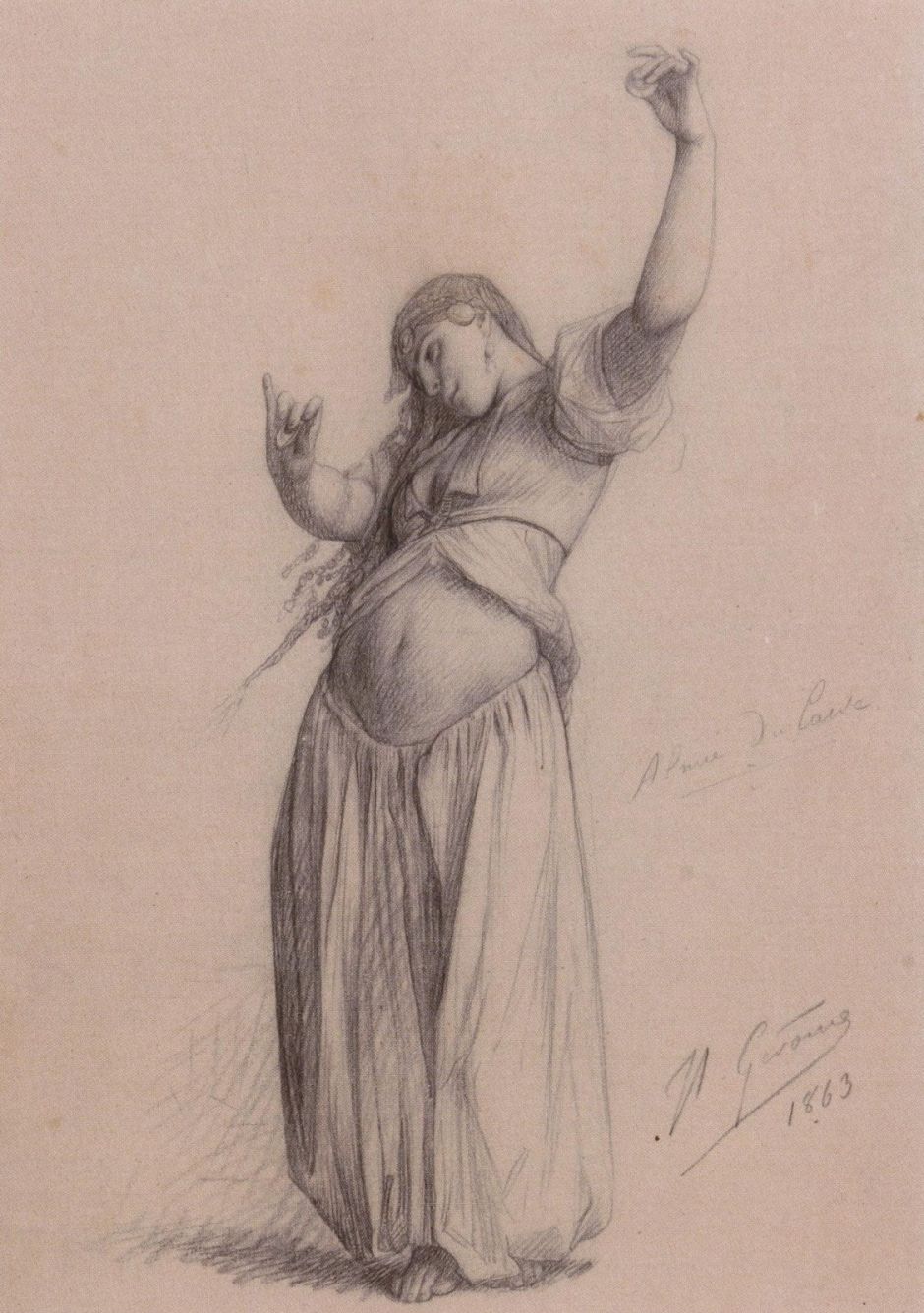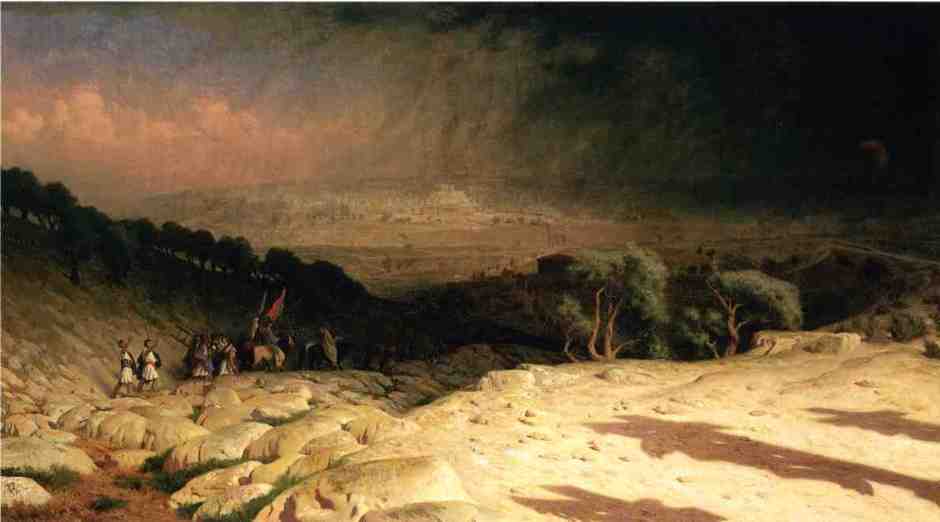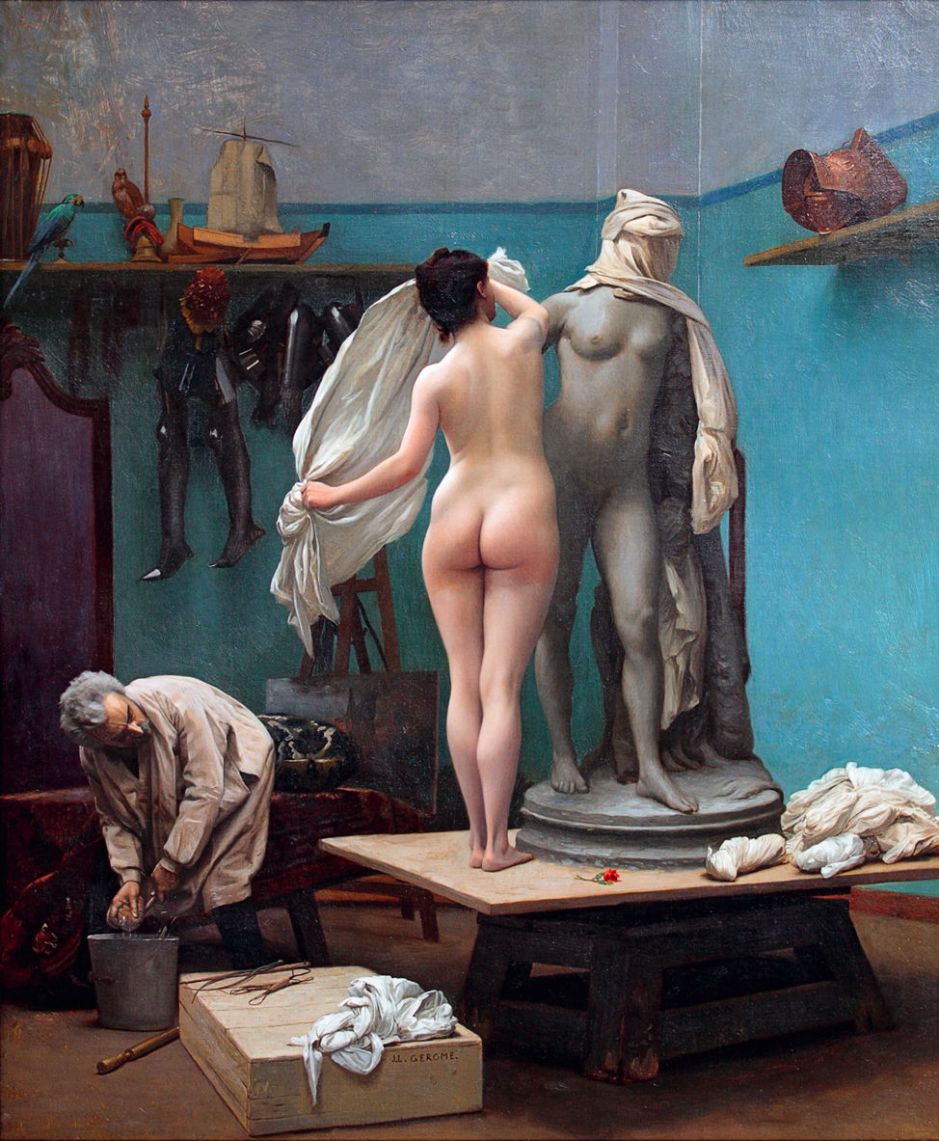I have already considered some of the highly detailed and ‘finished’ paintings of Jean-Léon Gérôme in the context of narrative. In taking me back to look at his work again, I realised that there was a lot more that needs to be said. I will here try to cover a bit more about his work and its importance.
Gérôme was, along with the likes of Bouguereau, the ‘enemy’ in the wars of Impressionism during the latter half of the 1800s. As Manet, Monet, Renoir, Pissarro, and the others were struggling to get their radical paintings seen and accepted, Gérôme was exhibiting several works each year at the Salon, selling through Goupil in the lucrative US market, and teaching at the École des Beaux-Arts in Paris. Gérôme was a cornerstone of established painting in France, and his work was exactly what the Impressionists opposed.
In the final decades of the 1800s, as Impressionism became ascendant, Gérôme’s popularity faded. Gérôme himself was as bitterly opposed to Impressionism as the Impressionists were to Gérôme. He insulted the Impressionists when Caillebotte’s bequest of his collection to the French state was being debated, just as the Impressionists had insulted his work when the need arose. After Gérôme’s death, his paintings and sculpture became largely forgotten. Twentieth century critics like Roger Fry helped ensure that – even though they had entered many public collections – they rested in store, unseen by the public.
It is largely through the lifelong work of one man, Gerald Ackerman, that Gérôme’s paintings are starting to appear again in the galleries and exhibitions. I agree that these paintings should be seen again, without the bitter hatred that grew in the 1800s, as works of art not conflict.
Jean-Léon Gérôme (1824–1904) – biography
The son of a goldsmith in Vesoul, France, he showed precocious talent for drawing when at school. His early paintings were seen by a friend of Paul Delaroche, and in 1840 he went to Paris to study in the studio of Delaroche. In 1843, following an accident, his master closed his studio and traveled to Italy, where Gérôme joined him and fell in love with Rome and the gladiators of classical times. However, this was cut short when Gérôme suffered typhoid fever, and had to return to Paris.
There, he joined Charles Gleyre’s studio for a period of three months, in preparation for his entry to the Prix de Rome, the prestigious prize for history painting. In 1844, Delaroche returned from Rome and Gérôme went back to his studio for a further year. In 1846, Gérôme moved in with the group of artists sometimes known as the ‘Néo-Grecs’ (Neo-Greeks), including Hamon, Picou, and Boulanger. They had a preference for subjects of antiquity, but opted for lighter, witty themes, feeling that classicism and neoclassicism were too serious and sober.

That same year, he entered the Prix de Rome, but one entry was only listed third, and his other was unranked. In 1847, he entered The Cock Fight for the Salon, earning a third-class medal, and selling it for a thousand francs. He started to achieve favourable reviews from critics, particularly Théophile Gautier. The following year he started to receive lucrative commissions, including a sale to the City of Paris for 12,000 francs.
He started to travel again in 1852, first visiting central Europe including Austria, but his plans were altered because of the Crimean War. In addition to annual success in the Salon, he showed at the Exposition Universelle in 1855 (the same boycotted by Courbet), and was appointed to the Legion of Honour. In 1856 he spent eight months in Egypt, presenting a group of the resulting paintings at the Salon the following year, to great acclaim.
In 1859, Gérôme entered into a business arrangement with Adolphe Goupil, for the Goupil galleries to represent him, make reproductions of his work, and to promote it, particularly in the US. Four years later, he married Marie Goupil, Adolphe’s daughter. In 1862 he travelled to Egypt and Syria, crossing the desert for the first time.
After the scandal over the Salon des Refusés in 1863, teaching at the École des Beaux-Arts in Paris was reformed into separate studios; Gérôme was named the head of one of the three. In 1868, he toured Egypt and Asia Minor, with visits to Cairo, Giza, Jerusalem, and crossing the Sinai desert. He returned for the opening of the Suez Canal the following year. He sheltered from the Franco-Prussian War of 1870-1 in England, where he exhibited at the Royal Academy.
In 1874, he was awarded a gold medal for three paintings at the Salon, but critics protested that such a medal should not be awarded for genre works. Gérôme tried to decline the medal, but the jury had already awarded it and would not rescind. In the end, Gérôme donated the medal for the benefit of students at the École des Beaux-Arts.
He was a late-comer to sculpture, but in 1878 showed his first large-scale sculpture alongside his paintings at the Exposition Universelle; his paintings were awarded a medal of honour, and the sculpture a second-class medal. In 1884, he publicly criticised Manet’s decadent lifestyle in opposing a retrospective exhibition of Manet’s paintings at the École des Beaux-Arts. He was forced to back down, and admitted that they were not as bad as he had feared. In 1894, he tried to block Caillebotte’s bequest of his collection of Impressionist paintings to the French State. He also launched an attack on Impressionism at the Exposition Universelle of 1900.
Among his more famous pupils were Mary Cassatt, Thomas Eakins, J Alden Weir, and even Odilon Redon, although the last for only a short period.
Early success

I have previously explained the narrative behind The Duel After the Ball (1857), which was based on a real duel in Paris. This painting was his most reproduced work, and one of his few narrative paintings which depicted a moment after the peripeteia. It is also unusual for the atmospheric vagueness in its background.

The Death of Caesar (1859-67) is another narrative work, showing the aftermath of the assassination of Julius Caesar on the Ides (15th) of March 44 BCE. Curiously he again shows a moment after the peripeteia itself, with the gloom of the Theatre of Pompey’s columns behind – strong parallels with The Duel After the Ball.

I have also explained the narrative in Phryné before the Areopagus (1861) in my other article about Gérôme. In essence, it concerns a well-known courtesan who disrobes in front of a court to arouse their pity. Although the cynical might consider this an elaborate packaging of, and excuse for, a nude, there is much more to this painting than its basic narrative or the female figure.
I think that it is one of the first of Gérôme’s works to explore themes which would occupy many more in the future: those of what is seen, visual revelation, and truth, particularly to nature. It is also a superb example of the importance of facial expression in narrative, and a demonstration of the power of Alberti’s ‘laws’.

This fine pencil study, presumably made from life, shows an early stage in Gérôme’s process. This might be followed by compositional sketches, then a reduced-size oil study. Several of the latter have survived, and show that even at that stage, his facture was quite highly ‘finished’, with little evidence of brushstrokes.

The final result, Dance of the Almeh (The Belly-Dancer) (1863) is one of his many Orientalist paintings, based on experiences during his trips to Egypt. Today these may seem trite, but at the time very few images were made of such places, and some showed locations which were hardly visited by Europeans.

Gérôme painted relatively few religious works, but of those Golgotha (Consummatum Est, or Jerusalem) (1867) is striking for its use of the shadows of the crucified, and for its exploration of the play of light, which was to become so central to Impressionism.

He produced several paintings showing Napoleon in Egypt, including this highly detailed and intricate version of General Bonaparte and his Staff in Egypt (1867). The French Campaign in Egypt and Syria had been in 1798-1801, so this was still relatively recent history, even when viewed from the distance of the final years of the Second Empire.
Sights and signs

Rapidly becoming a favourite painting of mine, Gérôme’s Pollice Verso (1872) was started after he had returned from the safety of London during the Franco-Prussian War, but was in no way intended as a comment on that war. Instead it is Gérôme the perfectionist looking again at the power of expression – this time, a small gesture of the hand – in his favourite context, the Roman gladiatorial arena, which he had fallen in love with when he was first in Rome in 1843.
Earlier attempts to show events in the arena had been somewhat marred by difficulties in achieving historical accuracy, in armour, weapons, and other details. Far from being a flight of fancy, Gérôme had spent a great deal of time and effort trying to make everything shown in this painting as historically accurate as possible at the time. Once again, the success of the painting depended on its fine details.


Gérôme painted at least two quite different views of The Wailing Wall (Solomon’s Wall) (1877) in Jerusalem, of which this is my favourite. Showing a single person at the Wall, it is an unusually simple motif, but I think the more moving in that simplicity.

His The End of the Pose (1886) is one of a series of very unusual compound paintings, which are at once self-portraits of Gérôme as a sculptor, studies in the relationship between a model and their sculpted double, and further forays into issues of what is seen, visual revelation, and truth.
Here, whilst Gérôme cleans up, his model is seen covering up her sculpted double with sheets, as she remains completely naked. Apart from various diversionary entertainments, including a couple of stuffed birds and a model boat, there is a single red rose on the wooden platform on which the model and statue stand. Presumably this is a symbol of thanks from the artist to his model.

Gérôme’s The Carpet Merchant (of Cairo) (1887) is one of the best of his many Orientalist paintings. It gives the carpets a grandeur from their display in very everyday surrounds. There is also a little mystery in the white-robed figure shown in the deep shadow of a doorway just to the right of the centre of the painting.
Faithful to reality
As his painting was reducing, and becoming less popular than those of the Impressionists, Gérôme turned more to sculpture, particularly that of polychrome marble. Those paintings that he did produce, though, were increasingly profound.

This version of Pygmalion and Galatea (1890) was an unsuccessful study, and he decided instead to paint a less controversial view from behind the couple, who are acting out the story of the sculptor who created a female figure in ivory, only to fall in love with it, and by kissing, transforming it into a real woman. This is, perhaps, the logical conclusion of his series of paintings of the sculptor at work, only in this one, Gérôme himself is of course absent.

The Colour Grinder (1891) is another Orientalist view, but one which refers very obviously to Gérôme’s painting, and perhaps to the Impressionists and their use of high chroma colours too.

Sculpturae Vitam Insufflat Pictura (Painting Breathes Life into Sculpture) (1893) is an interesting combination of manifesto for his polychrome sculpture, and a celebration of the archaeological discoveries at Tanagra, Greece. In doing so, it starts to approach the long-running theme of visual revelation and truth, with its painted miniature humans, mimicking reality, and the wooden box of masks in the foreground. The latter may also refer to some of his previous paintings.

His polychrome marble head of Sarah Bernhardt (1894-1901) is one example of his sculpted works. She lived from 1844 to 1923, and was at the height of her fame as an actress at the time. She had toured the world to great acclaim, and was particularly popular throughout Europe and the US, touring the latter on several occasions before and after Gérôme made this. The product of several years work, it remained in his possession at his death, and he bequeathed it to the French nation. Bernhardt was an accomplished sculptor and painter herself.

Truth Coming out of her Well to Shame Mankind (1896) is another oddity, this time the last of a short series of paintings which started with the naked figure of Truth at the bottom of the well. These are based on a quotation from Democritus, Truth lies at the bottom of a well, but knowing that reference is of little help in understanding these paintings.
It has been suggested that these relate to the Dreyfus affair in France, but as they predate Zola’s famous article J’accuse! of 1898, that seems implausible. I agree with more recent proposals that this Truth is the culmination of his themes of what is seen, visual revelation, and truth, particularly to nature. It is, perhaps, his last word on Impressionism, and his final defence of his life-long painting style.
It was not, though, Gérôme’s most unusual legacy. For that we must look to his entry for a competition, in his Optician’s Sign (1902). I have been unable to source a usable image of that, but refer you to this interesting article. I wonder whether that painting might have had any influence over more radical twentieth century works by the likes of Marcel Duchamp, perhaps?
Summary
It is easy to see how Gérôme could be dismissed as tawdry, populist, and devalued. But looking more carefully at his paintings now, they are not only masterful expressions of rich (and often contemporary) narratives, but many have a lot more to be found in them. His reliance on meticulous detail was often dictated by the painting as much as his style; that detail often carried important cues and clues which make his works so interesting.
His behaviour towards the Impressionists was unacceptable, but was reciprocated, and such artistic intolerance has marred much of the history of art. But there is no good reason to pretend now that Gérôme never existed. Let’s enjoy and appreciate his work for what it is.
References
The Story in Paintings: Jean-Léon Gérôme and the spectacular
Ackerman GM (2000) Jean-Léon Gérôme, Monographie révisée, Catalogue Raisonné Mis à Jour, (in French) ACR Édition. ISBN 978 2 867 70137 5.
de Cars L et al. (2010) The Spectacular Art of Jean-Léon Gérôme (1824-1904), Skira. ISBN 978 8 85 720702 5.

